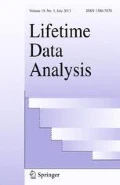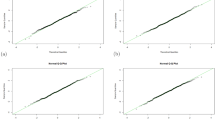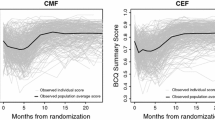Abstract
Longitudinal health-related quality of life data arise naturally from studies of progressive and neurodegenerative diseases. In such studies, patients’ mental and physical conditions are measured over their follow-up periods and the resulting data are often complicated by subject-specific measurement times and possible terminal events associated with outcome variables. Motivated by the “Predictor’s Cohort” study on patients with advanced Alzheimer disease, we propose in this paper a semiparametric modeling approach to longitudinal health-related quality of life data. It builds upon and extends some recent developments for longitudinal data with irregular observation times. The new approach handles possibly dependent terminal events. It allows one to examine time-dependent covariate effects on the evolution of outcome variable and to assess nonparametrically change of outcome measurement that is due to factors not incorporated in the covariates. The usual large-sample properties for parameter estimation are established. In particular, it is shown that relevant parameter estimators are asymptotically normal and the asymptotic variances can be estimated consistently by the simple plug-in method. A general procedure for testing a specific parametric form in the nonparametric component is also developed. Simulation studies show that the proposed approach performs well for practical settings. The method is applied to the motivating example.

Similar content being viewed by others
References
Albert SM, Castillo-Castaneda CD, Jacobs DM, Sano M, Bell K, Merchant C, Small S, Stern Y (1999) Proxy-reported quality of life in Alzheimer’s patients: comparison of clinical and population-based samples. J Mental Health Aging 5:49–58.
Albert SM, Castillo-Castaneda CD, Sano M, Jacobs DM, Marder K, Bell K, Bylsma F, Lafleche G, Brandt J, Albert M, Stern Y (1996) Quality of life in patients with Alzheimer’s disease as reported by patient proxies. J Am Geriatr Soc 44:1342–1347.
Albert SM, Jacobs DM, Sano M, Marder K, Bell K, Devanand D, Brandt J, Albert M, Stern Y (2000) Longitudinal study of quality of life in people with advanced Alzheimer’s disease. Am J Geriatr Psychiatr 9:160–168.
Andersen PK, Gill RD (1982) Cox’s regression model for counting processes: a large sample study. Ann Stat 10:1100–1120.
Cole BF, Gelber RD, Goldhirsch A (1993) Cox regression models for quality adjusted survival analysis. Stat Med 12:975–987.
Cole BF, Gelber RD, Gelber S, Mukhopadhyay P (2004) A quality-adjusted survival (Q-TWiST) model for evaluating treatments for advanced stage cancer. J Biopharmaceut Stat 14(1):111–124.
Cox DR (1972) Regression models and life-tables (with discussion). J Roy Stat Soc Ser B 34:187–220.
Dupuy J, Mesbah M (2002) Joint modeling of event time and nonignorable missing longitudinal data. Lifetime Data Anal 8:99–115.
Fairclough DL (2002) Design and analysis of quality of life studies in clinical trials. Chapman & Hall/CRC, New York, NY.
Fayers PM, Machin D (2000) Quality of life: assessment, analysis and interpretation. John Wiley & Sons, New York, NY.
Ghosh D, Lin DY (2002) Marginal regression models for recurrent and terminal events. Stat Sinica 12:663–688.
Hoover DR, Rice JA, Wu CO, Yang LP (1998) Nonparametric smoothing estimates of time-varying coefficient models with longitudinal data. Biometrika 85:809–822.
Lawless JF, Nadeau C (1995) Some simple robust methods for the analysis of recurrent events. Technometrics 37:158–168.
Lin DY, Fleming TR, Wei LJ (1994) Confidence bands for survival curves under the proportional hazards model. Biometrika 81:73–81.
Lin DY, Wei LJ, Yang I, Ying Z (2000) Semiparametric regression for the mean and rate functions of recurrent events. J Roy Stat Soc Ser B 62:711–730.
Lin DY, Ying Z (2001) Semiparametric and nonparametric regression analysis of longitudinal data (with discussion). J Am Stat Assoc 96:103–126.
Moyeed RA, Diggle PJ (1994) Rates of convergence in semiparametric modeling of longitudinal data. Aust J Stat 36:75–93.
Pepe MS, Cai J (1993) Some graphical displays and marginal regression analyses for recurrent failure times and time dependent covariates. J Am Stat Assoc 88:811–820.
Robins J, Rotnitzky A (1992) Recovery of information and adjustment for dependent censoring using surrogate markers. In: Jewell N, Dietz K, Farewell V (eds) AIDS epidemiology-methodological issues. Birkhauser, Boston, pp 297–331.
Stern Y, Sano M, Paulson J et al. (1987) Modified mini-mental state exam: validity and reliability (abstract). Neurology 37(suppl1): 179.
Zeger SL, Diggle PJ (1994) Semiparametric models for longitudinal data with application to CD4 cell numbers in HIV seroconverters. Biometrics 50:689–699.
Zhao H, Tsiatis AA (1997) A consistent estimator for the distribution of quality adjusted survival time. Biometrika 84:339–348.
Acknowledgement
The authors would like to thank the Associate Editor and two referees for their insightful and constructive comments. This research was supported in part by grants from the National Institutes of Health, the National Science Foundation and the New York City Council Speaker’s Fund for Public Health Research.
Author information
Authors and Affiliations
Corresponding author
Appendix
Appendix
Proof of Theorem 1
(i) Recall that the estimating Eq. (3.9) is used to estimate γ, for convenience, denote
The consistency of \(\hat{\gamma}\) follows from the almost identical arguments in Appendix A.1 of Lin et al. (2000). Thus, we omit the details.
Now we sketch the proof of \(n^{1/2}(\hat{\gamma}-\gamma)=n^{-1/2}\sum_{i=1}^n \psi_i +o_P(1)\). The Taylor series expansion of \(U_{n0}(\hat{\gamma}, \hat{\xi})\) at \((\gamma, \hat{\xi})\) and the law of large numbers lead to
Note that
Following Lin et al. (1994),
Plugging (A.3) and (A.2) into (A.1) and interchanging integrals, we get \(n^{1/2}(\hat{\gamma}-\gamma)=n^{-1/2}\sum_{i=1}^n \psi_i +o_P(1)\).
(ii) Since \(\hat{\gamma}\), \(\hat{\xi}\) are consistent, the consistency of \(\hat{\beta}\) follows from the expression (3.12) by applying law of large numbers.
Let
Clearly, \(-\frac{{1}} {{n}} \frac{{\partial U_{n1}(\beta,\gamma,\hat{\xi})}} {{\partial \beta}}\) converges to D as \(n\rightarrow \infty\). As in Lin and Ying (2001), \(-\frac{{1}}{{n}}\frac{{\partial U_{n1}(\beta,\gamma,\hat{\xi})}} {{\partial \gamma}}\) converges in probability to H. Thus, the Taylor series expansion of \(U_{n1}(\hat{\beta},\hat{\gamma},\hat{\xi})\), and the law of large numbers lead to
Now
Plugging (A.3) into (A.5) and interchanging integrals with simplification, we get
Plugging (A.6) and the asymptotic expression of \(n^{1/2}(\hat{\gamma}-\gamma)\) in (i) into (A.4), the asymptotic expression of \(\hat{\beta}\) follows.
Proof of theorem 2
Note that \(n^{1/2}[\hat{\mathcal{A}}(t;\hat{\beta},\hat{\xi},\hat{\gamma}) -\tilde{\mathcal{A}}(t;\hat{\theta},\hat{\xi},\hat{\gamma})]\) can be decomposed as follows:
where
With the expression (3.13) of \(\hat{\mathcal{A}}(t;\beta,\xi,\gamma)\), after some algebra, we get
Moreover, by the expression (3.11) of \(\hat{\Lambda}\) and Taylor series expansions,
The consistency of \(\hat{\gamma}\) and \(\hat{\xi}\) and Taylor series expansion, we can get
In addition,
Recall that D 1 is the limit of \((-1/n)[(\partial{U}_n(\theta;\beta))/(\partial {\theta})]\), D 2 is the limit of \((-1/n)[(\partial{U}_n(\theta;\beta))/(\partial {\beta})]\), D x (t) is the limit of \(-\frac{{1}} {{n}}\sum_{i=1}^n\int_0^t \frac{{X_i(s)\delta_i^*(s) d N_i^*(s)}} {{R_{z1}(s;\hat{\gamma})}}\). With Taylor series expansion, notice that
which leads to,
Use the asymptotic representation (A.3) of \(\hat{\delta}_i^*(t)-\delta_i^*(t)\) and the fact that
we can get \({n}^{1/2} (\hat{\mathcal{A}} (t;\hat{\beta},\hat{\xi},\hat{\gamma}) - \tilde{\mathcal{A}}(t;\hat{\theta},\hat{\xi},\hat{\gamma})) =n^{-1/2}\sum_{i=1}^n \Gamma_i(t) +o_p(1)\), where
This completes the proof. □
Rights and permissions
About this article
Cite this article
Jin, Z., Liu, M., Albert, S. et al. Analysis of longitudinal health-related quality of life data with terminal events. Lifetime Data Anal 12, 169–190 (2006). https://doi.org/10.1007/s10985-006-9002-4
Received:
Accepted:
Published:
Issue Date:
DOI: https://doi.org/10.1007/s10985-006-9002-4




